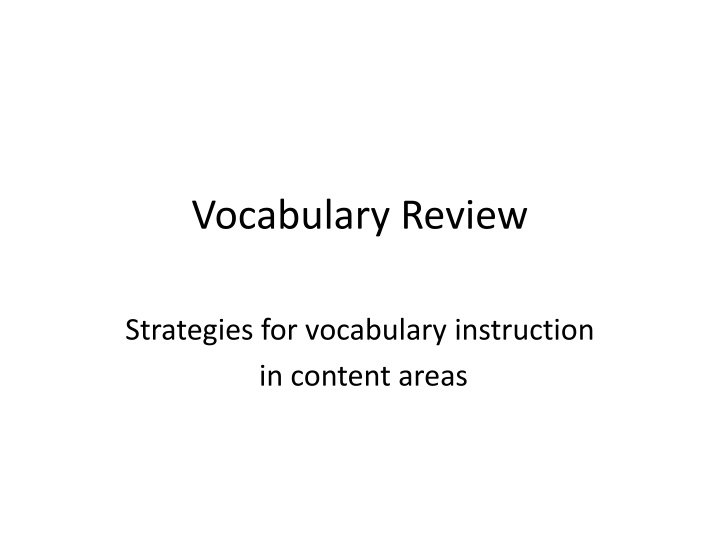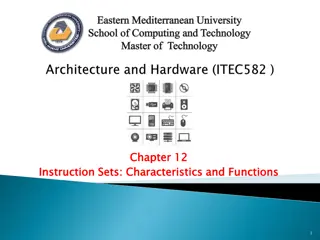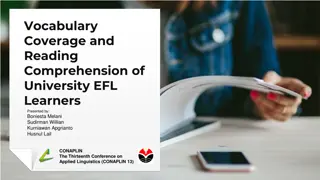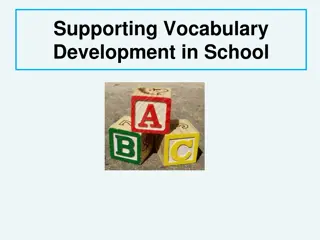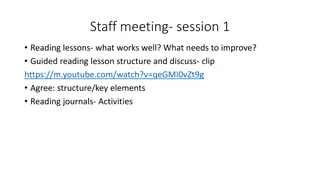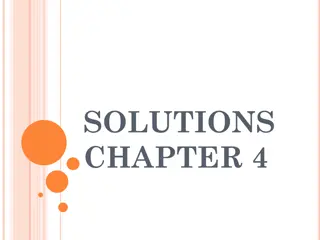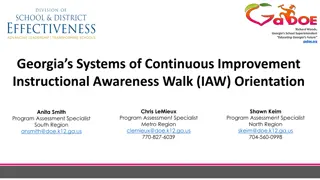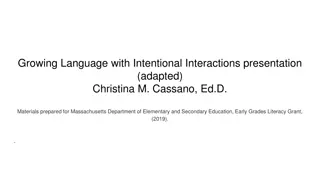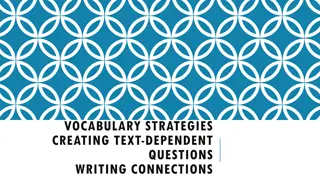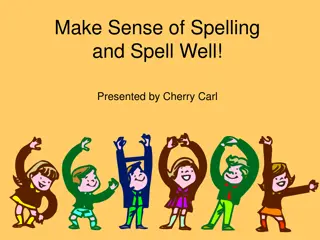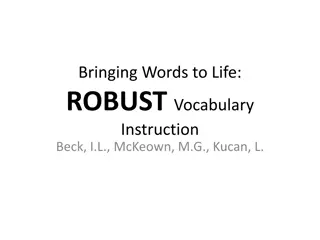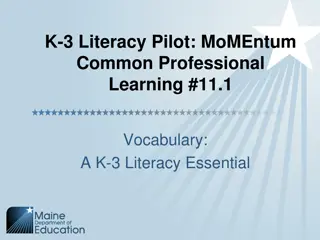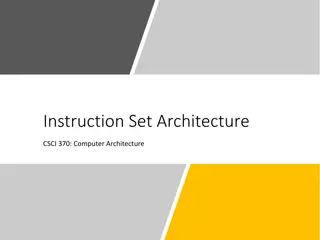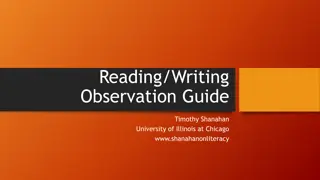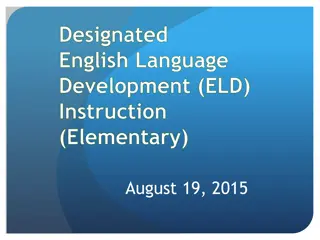Effective Vocabulary Instruction Strategies for Content Areas
Utilize strategies such as selecting the right words, focusing on important, useful, and difficult terms, and categorizing vocabulary into tiers for better comprehension. Avoid ineffective methods like assigning random words from textbooks. Explicit instruction and providing student-friendly definitions are key components for successful vocabulary learning in diverse subjects.
Download Presentation

Please find below an Image/Link to download the presentation.
The content on the website is provided AS IS for your information and personal use only. It may not be sold, licensed, or shared on other websites without obtaining consent from the author.If you encounter any issues during the download, it is possible that the publisher has removed the file from their server.
You are allowed to download the files provided on this website for personal or commercial use, subject to the condition that they are used lawfully. All files are the property of their respective owners.
The content on the website is provided AS IS for your information and personal use only. It may not be sold, licensed, or shared on other websites without obtaining consent from the author.
E N D
Presentation Transcript
Vocabulary Review Strategies for vocabulary instruction in content areas
SELECTION OF VOCABULARY WORDS How many words per week do you think students should be required to learn? You will probably be able to thoroughly teach only a few new words per week perhaps 8 or 10!! Remember-those would include words in ALL subject areas not just reading!!
SELECTION OF VOCABULARY WORDS What words should you teach? Focus on three types of words: Important- integral for understanding a concept or the book Useful- words that might be used again and again across contexts and in conversation Difficult- multiple meaning and idiomatic expressions- These can be especially difficult. Content related words (i.e. photosynthesis, map key, scale, etc.)
Tiered Words Tier 1-requires no instruction, concepts that are already familiar (i.e. baby, cry, house, etc.) Tier 2-More sophisticated synonyms for words many children know can be used daily. Students encounter these words in texts, less often in spoken language (i.e. infant, bawled, residence, etc.) Tier 3-Content/Domain specific-words used in content areas like science, social studies, history, and or math classes (i.e. volcano, atmosphere, cumulus cloud, Emancipation Proclamation, Pythagorean theorem)
Avoid Teaching or assigning words from textbooks just because they are highlighted in some way (italicized, bold face print, etc.). Teaching or assigning words just because they appear in a list at the end of a text chapter. Assigning words the teacher cannot define. Assigning large quantities of words. Assigning words that students will rarely encounter again.
An example of explicit instruction: 1. Introduce the word fancy. Read the word to the students Say the word fancy with me. Look at the little word fan and then the ending cy . The c makes an s sound and they y makes a long e sound in this word Say it in a sentence. I like to dress up in my fancy clothes when I go to a party.
2. Provide a Student Friendly Definition Fancy means to go above the normal. It is more than your ordinary, every day stuff. Student-Friendly Explanation (Beck, McKeown, & Kucan, 2003) Uses known words. Is easy to understand.
3. Illustrate the word with examples or pictures. Here are some pictures of some fancy things. Let s take a look. There are some ladies in fancy dresses. The dresses are very formal; there are not the kinds of dresses we wear everyday to school or work. The dogs are fancy with their hats and bows. We even see a fancy table setting.
4. Check for understanding. Look at this picture of these men. Are they fancy? Why or why not? What kinds of things do you wear when you are being fancy? Or what do you see your mom or dad wear when they dress in fancy clothes?
Provide multiple exposures -Review the words after you finish the book. -Match the words to the corresponding pictures/concepts in the book. -Use the word in other contexts/conversations during the day. -It is also helpful to require students to actively work with words, use in sentences, redefine, classify, etc.
Another Vocabulary Review Idea The students all have a page with the vocabulary pictures. The teacher asks questions and the students point to pictures or chorally respond to questions. Examples: Touch the picture that shows a troop . Touch the picture that shows that someone is victorious . What does it mean to be victorious ? Touch the picture that shows someone is happy about something they did. What is the vocabulary word? Touch a picture that shows someone has done something that is hard. What is the vocabulary word? Touch the picture that shows farewell . What does farewell mean?
Try a Vocabulary Overview Guide 1. Together, review tier 2 words , their meaning, what they may look like. 2. Have students read a book, paragraph, chapter, etc. 3. As they read, remind them to attend/look for tier 2 words. 4. After reading, distribute the vocabulary overview guide for students to complete. 5. Upon completion, have students share their tier 2 words identified from their reading. 6. Be sure to refer and use tier 2 words in your daily instruction or display on a word wall if these are important for student understanding.
Vary the Types of Independent Vocabulary Practice Activities! Example of Independent Activities: Day 1: Write new vocabulary words on vocabulary cards to add to a vocabulary ring or vocabulary card file. Day 2: Write student-friendly definitions on back of vocabulary cards. Day 3: Complete Word Diagram or Four Square Page with 4 new vocabulary words. Day 4: Complete Word Diagram or Four Square Page with 4 new vocabulary words. Day 5: Partner up and test each other on vocabulary definitions (using vocabulary cards students take turns saying the word and the other student gives the student- friendly definition -- or -- one student gives the student-friendly definition and the other student says the word).
Using Structural Analysis in Vocabulary Development Many words in the English language are made up of words parts called prefixes, roots, and suffixes. These word parts have specific meanings that, when added together, can help you determine the meaning of the entire word. Example: The students thought the book was incomprehensible. in = not Comprehen = to understand ible = able to do something; also changes this word from verb to adjective incomprehensible = not able to understand
Structural Analysis In most cases, a word is built upon at least one root. Words can have more than one prefix, root, or suffix. Two or more roots geo/logy: earth/study of Two prefixes in/sub/ordination: not/under/order Two suffixes beauti/ful/ly: beauty/full of- noun to adjective/ly- adjective to adverb Words do not always have a prefix and a suffix. Some words have neither a prefix or a suffix read Others have a suffix but no prefix read/ing Others have a prefix but no suffix pre/read
Structural Analysis The spelling of roots may change as they are combined with suffixes Root: terr/terre = territory Different prefixes, roots, or suffixes may have the same meaning: bi-, di-, duo- all mean two Sometimes you may identify a group of letters as a prefix or root but find that it does not carry the meaning of that prefix or root: Ex. The letters mis in the word missile are part of the root and are not the prefix mis- which means wrong; bad Prefix, Suffix and Root tables
Word Family Tree Try a word family tree for structural analysis and vocabulary development (see example). Choose one content specific word for students to process the meaning and structural analysis.
References Armbruster, B. B., Lehr, F., & Osborn, J. (2001). Put reading first: The research building blocks for teaching children to read. Retrieved from Put reading first Beck, I.L., McKeown, M.G., & Kucan, L. (2014). Bringing words to life: Robust vocabulary instruction. (2nd ed.). New York, NY: Guilford. Buehl, D. (2014). Classroom strategies for interactive learning. (4th ed.). Newark, DE: International Reading Association. Trelease, J. (2013). The read-aloud handbook. New York, NY: Penguin. Yaeger, J.A. (2014). Wisconsin foundations of reading study guide. Retrieved from jenniferyaeger.weebly.com
